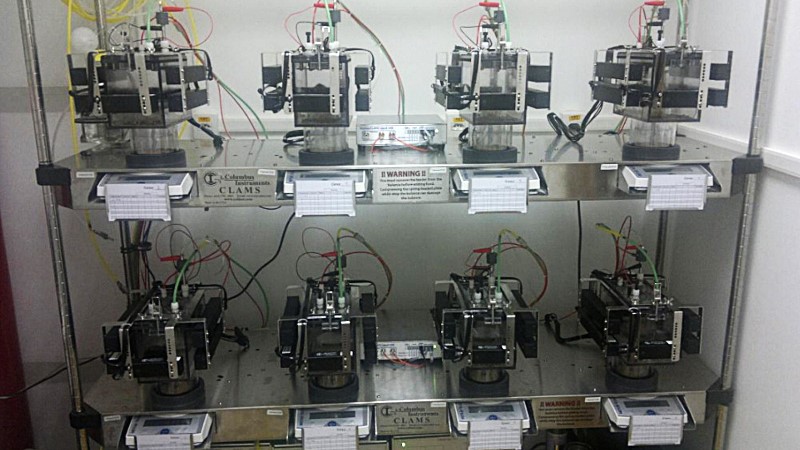


Respirometric chambers in Professor José Donato Junior's laboratory, used to study rodents (photo: Laboratory of Neuroendocrinology and Metabolism/USP)
Published on 10/28/2025
By Luciana Constantino | Agência FAPESP – Amid advances in anti-obesity treatments, an international group of approximately 80 researchers from 18 countries, including Brazil, has created a new standard for measuring energy expenditure. In an article published in the journal Nature Metabolism, the scientists present standardized rules and units for analyzing energy expenditure in experimental models (rodents), replacing the practice of dividing metabolic rates by body weight.
The standardization aims to obtain replicable, comparable, and consistent results, thus allowing the creation of a database that can be used with advanced analysis techniques, such as artificial intelligence. Standardization opens up a range of possibilities for developing preclinical tests for new classes of drugs against obesity and other metabolic diseases that focus on energy expenditure.
"Complex and multifactorial diseases, such as diabetes, atherosclerosis, and hypertension, are usually treated with at least two to three medications. When this combination exists, it's possible to reduce the doses of each one individually, thereby increasing efficacy and safety for the patient," says Licio Augusto Velloso, a physician, director of the Obesity and Comorbidities Research Center (OCRC), and one of the authors of the article. "In the case of obesity, even with the revolution in treatments in recent years, studies show that new drugs only reduce hunger without increasing energy expenditure. The ideal therapy for obesity is for both things to occur: the patient feels less hungry and expends more energy. The big problem was standardizing the methods for measuring this energy expenditure," the researcher explains.
The OCRC is a Research, Innovation, and Dissemination Center (RIDC) based at the State University of Campinas (UNICAMP) in the state of São Paulo, Brazil. It is funded by FAPESP.
Over the past decade, obesity treatment has advanced with the introduction of drugs analogous to the hormone GLP-1, such as semaglutide (the active ingredient in Ozempic) and tizerpatide (in Mounjaro). These drugs act on the central nervous and digestive systems, promoting satiety and reducing hunger.
However, there is still an opportunity to develop drugs that stimulate adipose tissue cells to expend energy and produce heat in a process called thermogenesis to promote weight loss.
Another recent article published in Nature Metabolism presented an experimental drug that prevents fat accumulation, even with a high-fat diet. This drug also treats obesity and reverses associated metabolic dysfunctions (read more at https://agencia.fapesp.br/55133).
According to the World Obesity Atlas 2025, more than 1 billion people worldwide live with the disease, which is linked to approximately 1.6 million premature deaths annually. In Brazil, it is estimated that 31% of the population is obese, and between 40% and 50% of adults do not engage in physical activity at the recommended frequency or intensity.
Standardization
In the article, the researchers present a set of standardized units for indirect calorimetry experiments. Indirect calorimetry is a test that measures the amount of calories the body expends.
The units are as follows: oxygen consumption and carbon dioxide production measured in milliliters (mL) per hour; energy expenditure in kilocalories (kcal)/h; energy intake in kcal/h; water intake in mL/h; physical activity in meters; and respiratory exchange ratio.
Most studies assessing energy expenditure are conducted in laboratories with rodents. The animal is placed inside a respirometric chamber. This equipment is completely sealed and constantly measures oxygen and carbon dioxide. It also has sensors that monitor the rodent's body temperature and movement. A mouse chamber costs, on average, about US$30,000. Laboratories usually have 10 to 12 units.
"This long-awaited initiative can significantly improve the accuracy and depth of mammalian metabolism research, enabling the discovery of subtle but physiologically relevant effects and population patterns that individual studies often fail to detect," writes the group, led by Alex Banks, who is chair of the International Consensus Committee on Indirect Calorimetry and director of the Energy Balance Center at Beth Israel Deaconess Medical Center (BIDMC) at Harvard Medical School.
José Donato Junior, a professor at the Institute of Biomedical Sciences at the University of São Paulo (ICB-USP) and one of the Brazilian authors of the article, points out that the lack of standardization creates problems in scientific literature. This leads to studies with different conclusions due to the way the data is analyzed.
"Each researcher, largely due to the way the equipment provides information, ended up presenting the data in a different way. So, the idea behind this publication was to bring together an international consortium with scientific credibility to propose new standards," Donato Junior explains. He is also part of the OCRC and coordinates the Laboratory of Neuroendocrinology and Metabolism at USP, one of the few in Brazil with a respirometric chamber.
The researchers cite the human genes ALK7/Acvr1c and Activin E/Inhbe as an example of problems caused by the lack of standardization. These genes are associated with changes in body composition. Human genetic variations in the Acvr1c and Inhbe genes are related to differences in waist-to-hip ratio and the development of type 2 diabetes. In mice, removing any of the Acvr1c, Inhbe, or Gdf3 genes alters body weight. However, the cause of this obesity and whether it is shared among the models remains uncertain due to the different analytical methods.
Through the publication of the article, the researchers hope to encourage leading scientific journals that focus on metabolism to adopt these standards when evaluating articles for publication. They also plan to share the standards at conferences and events in the field.
The article "A consensus guide to preclinical indirect calorimetry experiments" can be read at https://www.nature.com/articles/s42255-025-01360-4.
Source: https://agencia.fapesp.br/56286